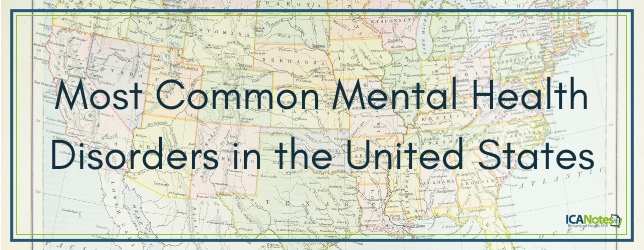What Are the Most Common Mental Health Disorders in the United States?

It’s very clear that there is a mental health problem in this country, with about 44 million American adults having a diagnosable mental health disorder. What are the most common mental health disorders in the United States? What are the consequences, and what can be done as far as treating mental disorders?
Most Common Mental Health Disorders
While some might guess that the leading mental health disorder in the United States is depression, the clear leader in mental disorders is anxiety, with a little over 18 percent of the total adult population in the United States, suffering from some kind of anxiety disorder.
Depression is not far behind. About 16 million Americans, or 6.9 percent, deal with major depression. A little over six million live with bipolar disorder. Rounding out the list is schizophrenia, which affects about one in every 100 American adults, or close to 2.4 million.
Impact of Common Mental Health Disorders
The effects of mental health disorders can be devastating. Depression is the leading cause of disability around the world. An estimated 90 percent of suicides, the 10th leading cause of death in the United States, have been linked to mental illness. Over $193 billion in earnings are lost every year due to mental illness, and 26 percent of homeless adults in shelters and 24 percent of state prisoners have mental health conditions.
Treatment Options for Common Mental Health Disorders
Part of the reason for this mental health epidemic in the U.S. is the lack of adequate treatment options. Close to 60 percent of adults suffering with mental illness did not receive any treatment in the previous year, as well as nearly half of youth with mental disorders. It is even worse for minorities. African Americans and Hispanic Americans used mental health services about half as much as whites in the last year, with Asian Americans using them about a third as much.
So, what can be done? The most important thing we can do for the mental health epidemic is to remove the stigma that is still associated with receiving mental health services. Because a mental disorder cannot always be seen in the way that a physical ailment can, the response is often that the sufferer should “get over it,” or “it’s all in their head.” This is an attitude that must be countered by education and anecdotes from public figures and role models who have suffered from mental illness.
It is also important to institutionalize treatment for mental disorders. More workplaces need to make allowances for mental health issues, and more insurance companies need to cover behavioral treatments more fully.
The more the impact of mental health disorders in our country is recognized and addressed, the better chance we have of improving the quality of life for the many Americans who suffer from these conditions.
If you are a behavioral health professional and need help organizing your medical records and billing, contact ICANotes for a free trial of our extremely robust behavioral health EHR.
